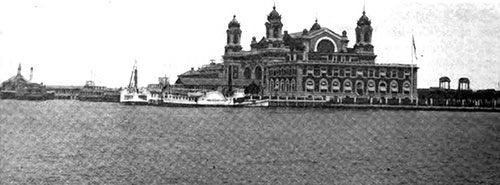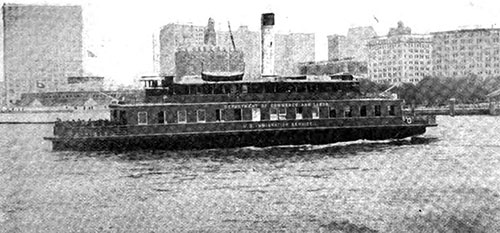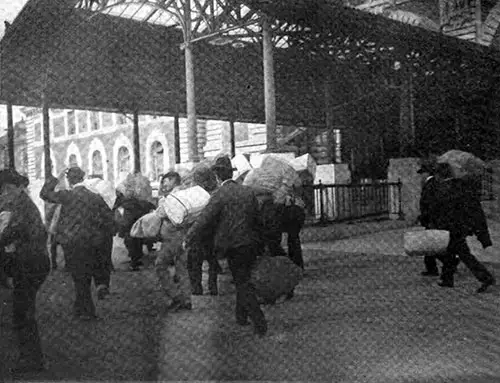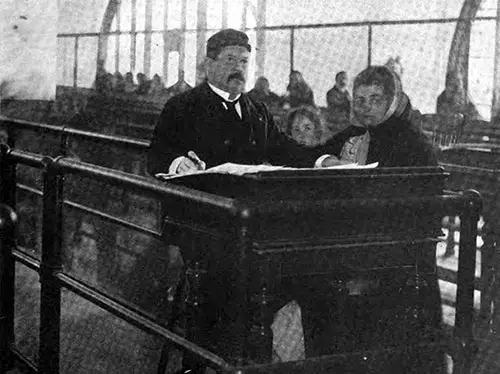How Immigrants Are Handled - A Business Perspective - 1905

Government Building at Ellis Island, Just off the Battery in New York, Where Immigrants Land and Are Inspected and Checked Off; From Here Barges Convey Immigrants to Various Transportation Stations. System - A Monthly Magazine, October 1905. GGA Image ID # 14f200bb2e
The system by which the United States government examines and sends on their way as many as 12,000 immigrants in a single day—as easily, as methodically and smoothly as though they were so many sacks of grain.
Dump a shipload of immigrants in a corner of this country, and unless those immigrants are immediately distributed that corner will become as choked as the corner of a farm on which is dumped a carload of fertilizer.
The success of fertilization lies in distribution, and it is the prompt distribution of these successively arriving bodies of immigrants that composes the problem of the united States immigration authorities.
Of the million immigrants who are crowding to this country during the present year—a million is the number estimated by the government officials-8o per cent, or 800,000, reach the port of New York.
Twice during the month of May, the daily arrival reached 12,000 people. These 12,000 people were poor. Many of them had only a few pennies worth of foreign money, a pack of personal belongings, and a railroad ticket, in most cases purchased by a relative in this country.
Whatever the possibilities in this untaught and uncouth body of humanity, the immediate problem is their distribution before their resources give ' out, and they become public charges.
The country needs these immigrants in its development—there is work for them to do. But the country does not need them at one point any more than the farm needs the fertilizer at one point.
To distribute these immigrants with as much despatch as possible has, during the past two years fallen under the province of the Department of Commerce and Labor.
So efficiently is this work being developed, that the systems which are in operation have proven themselves capable of landing, inspecting and distributing to the various. transportation companies over 12,000 immigrants a clay, and this within a few hours.
Ninety-seven steamship lines enter the port of New York. They carry passengers from all the continents of the globe. For this reason the methods of the officials at this port are of more interest than those of any other port in the world.
How Immigrants are Received by the Government
Ninety-nine out of every hundred immigrants arrive in New York with tickets to specific points—a fact which offers a striking rebuke to the daily press who bewail the flow into this country of "undesirables," who float aimlessly with no objective point. Of this number, over three-quarters leave New York on cars.
They do not come aimlessly as they once did. They have a definite objective point which they want to reach without delay. The government helps them to this end. It has to, a delay in disposing of the new arrivals would congest New York to a dangerous point.
All steerage passengers, upon the arrival of the steamers at New York, are landed at Ellis Island. Immediately upon their landing, they are conducted to the main government building, and onto the registration floor.
The registration floor is a large hall divided by metal gratings and railings into runways and compartments. Each ship load of passengers is lined up in single file and made to pass before the government doctors.
In cases where contagious diseases are suspected, the immigrant is assigned to a waiting room on the right where he undergoes a more careful inspection later.
Immigrants who pass the test satisfactorily are passed on to the left where they enter that one of the twenty-five runways which bears the number on the tag with which they are placarded by the immigration authorities, as soon as they embark.
Each ship load of immigrants is divided into groups of thirty passengers each. Each group is known as a "manifest" group, as thirty names only are allowed on each manifest.
Each manifest bears a number from i to a to correspond to the numbers of the runways on the registration floor at Ellis Island. In this way a ship load of immigrants are inspected and checked by the government officials in the very shortest possible time.
As the system obviates all delays and confusion in comparing the information on the manifest sheets with the information supplied personally by the immigrant who is passing inspection at New York.
In order to avoid fraudulent registration. these manifest sheets contain the name of each immigrant, a brief description of his physical appearance, the name of his parents, age, destination, place of birth, amount of money in his possession, and other data.
Upon the immigrants' arrival at Ellis Island, this information must tally with the information supplied by the immigrant in response to the questions of the immigration officials.
In this way substitution is made practically impossible, as any fraud which is detected, is promptly discovered and the suspect is detained, possibly to be returned at the expense of the steamship companies to the port from which he came.
Officials Distribute or "Route" Each Person to thier Destination
As the government authorities check each immigrant, they present him with an authorization ticket, on which is indicated his point of destination. This ticket serves as the immigrant's authority for presenting his railroad order in exchange for a railroad ticket, and directs him to the proper railroad or steamship officials, in accordance as to whether his destination is East, West, North or South.

U.S. Immigration Service Boat Which Carries Visitors to Eilis Island and Immigrants Free of Charge Between the Island and the Battery. System - A Monthly Magazine, October 1905. GGA Image ID # 14f2111fa6
The immigrant first presents this ticket to the uniformed guides who are stationed at the point where the immigrant leaves the hands of the government authorities.
If his ticket is to a point in the West, he is directed to the ticket office of a representative of that railroad whose lines go to the point named. Here he exchanges the pass bought at his point of embarkation, and receives in return a third-class ticket to his point of destination.
In this distribution the government authorities must necessarily work in connection with the transportation companies. Every transportation company whose terminals are in New York, are represented at Ellis Island by their own officials who conduct their own offices under the direction of the home authorities, who pay the government rental in the same way that they would pay rental for offices owned by private concerns.
Usually a number of railroads are represented by one agent who is in charge of the employes at that point, and whose expenses are shared proportionately by the transportation companies he represents.
All immigrants must secure their tickets from this "Immigrants Clearing House." Those who go West must go over one or more of the nine railroads whose lines meet in New York. Those who go East must go over one or more of the three railroads or three steamship companies which go to points in New England.
Those who go South and North likewise, must buy their tickets over the railroad or steamship lines which are represented by employees at Ellis Island. In this way but a very short time elapses from the moment when the immigrant lands and the time that he exchanges his railroad ticket.
As soon as the immigrant's ticket is secured, he is at once directed to the checking room. This is a large floor around the walls of which are hung placards bearing the names of all the railroad and steamship companies.
As each immigrant presents his ticket to the official, his baggage is weighed, checked, and piled in that part of the floor which is near the placard containing the name of the railroad on which the baggage is Checked. So effective is this system that not a piece of baggage has been lost for twelve years.

Immigrants Just Arriving at Ellis Island—as They Look on Disembarking From the Steerage Quarters of the Ocean Liner, Carrying All Their Worldly Possessions With Them. System - A Monthly Magazine, October 1905. GGA Image ID # 14f22e48b8
The immigrant is then passed on to the waiting-room. This room is divided into a number of large compartments. each of which bears the names of those railroads over which the immigrants are to be carried.
As each compartment is filled, a door at the further end is opened and the immigrants are transferred to a government barge. These barges connect Ellis Island directly with all the steamship and railroad companies.
In the few cases in which the barges do not land the passengers directly at the depots. uniformed guides are sent with each boat load who place them on the cars of the New York transportation companies and deliver them to the railroad stations.
The Immigrant is Started Safely on His Journey
Upon their arrival at the railroad stations, the immigrants are assigned to immigrant cars, old coaches which are usually attached to the regular trains.
When immigrants are assigned to points in the far West, tourist sleepers are used—the now obsolete sleeping cars which were in use twenty years ago, and which have now been supplemented by the modern Pullman and Wagner.
When a large number of immigrants are thus entrained, a uniformed interpreter makes the journey with them to prevent losses -along the route, particularly, at points of transfer.

Registration Room in Ellis Island, Where Immigrants Are Examined and Classified According to the Railroad or Steamship Stations to Which They Are to Be Sent to Continue Their Journey. System - A Monthly Magazine, October 1905. GGA Image ID # 14f237f59a
In this way the tide of in flowing humanity is kept moving. Every year brings greater numbers of immigrants, and each year the systems for handling them have been expanded, until it meets the conditions.
The vast development of this country the last three quarters' of a century would have been impossible without the help of the 20,000,000 immigrants who have come to our shores in that period.
This country has not by any means yet reached its final development, and there is still need and room for the strength of the foreigner. But seventy-five years ago the whole country was in a crude stage; now only certain sections are open to development. It is these sections only that need the immigrant.
In order that the commercial interests place these immigrants where they will do the most good, where they can answer the industrial needs of the country, it would seem that there ought to be some system by which they could be distributed to the localities where they are needed.
This question was put up to the government officials.
"To what 'extent can the government regulate the distribution of immigrants?" was asked of the inspector of immigration.
"The government can exercise no jurisdiction in that matter," was the reply. "Such action on the part of the government would be too paternal to conform with American principles. I do not believe that the time will ever come when this government wilt dictate to its immigrants in what places they will have to settle."
Although it is true that this government does not and probably never will regulate this phase of the immigration problem, it is an open secret that foreign governments not only encourage their residents to come to this country, but even send them to certain specified localities which are selected and often encouraged in growth by their consular representatives.
At the present time, Baron Planches, the Italian ambassador to the United States, accompanied by representatives of a western railroad, is touring the South with the view of recommending the country south of Mason and Dixon line as favorable for the settlement of Italian immigrants.
So also the Austro-Hungarian government encourages certain classes of its subjects to come to the United States and exercise an almost paternal influence over them after their arrival here.
The Austro-Hungarian government issues publications containing comprehensive instructions to Austrians who contemplate settling in this country.
These publications give specific information in regard to routes and reviews of the peculiar economical conditions which are favorable toward their settlement. An extract from the Austrian official publication reads as follows:
"By order of the Royal Hungarian Governor in Fiume, we call the attention of every immigrant to the fact that it is advisable, in his own interest and in that of his family also, that he should report his residence, and later changes of the same, to the nearest Austro-Hungarian Consul.
"The Hungarian Government has provided that the immigrant coming from Hungary shall be taken care of in Hungarian institutions, where he can get advice. So the immigrant is protected by the Hungarian Government, not only during his voyage, but even in America.
"On foreign steamers which do not sail from Fiume and which carry Hungarian immigrants against the law, the Hungarian Government is not able to protect the Hungarian immigrant."
So also do many other countries make it easy for their subjects to find quarters in America, and not only directs them to settlements where they will find their countrymen, but sees to it that native guides meet the new arrivals and direct them safely to their destination.
Some say the 800,000 immigrants who reach America's shores each month are a burden; this is probably not so true as some have sought to prove.
But suppose they are a burden to some extent—would the United States not be making an apparent evil a good if it had an organization and a system which would enable it to put these immigrants where they can do productive work—where they are needed? There are still many such localities in this land.
That system is the best which .uses to the greatest advantage the materials it has to work with.
Why should not the government's system be put to the same test? A faint heart never won fair dividends; and the man who does not believe he can—seldom does.
Self-confidence is the general manager—the pusher—the director of the master mind. It decides that the thing can be done—and spurs, drives, inspires the man to do it. It is the breeder of courage; the foundation of resolve; the stimulator of energy and genius.
It revels in competition; sneers at gibes; pooh-poohs the insurmountable; gives the weak the strength to oppose the strong, the one-man business the COURAGE and determination to outclass the giant corporation.
"Impossible? —There is no such word in the dictionary I" That's self confidence and almost—SUCCESS.
Manners, O. N., "How Human Imports Are Handled" in System: A Monthly Magazine, Volume VIII, No. 4, October 1905, pp. 333-338.
